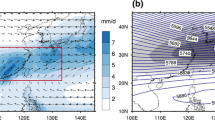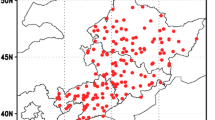Abstract
In the present study, the authors investigated the relationship between the Arctic Oscillation (AO) and the high-frequency variability of daily sea level pressures in the Northern Hemisphere in winter (November through March), using NCEP/NCAR reanalysis datasets for the time period of 1948/49–2000/01. High-frequency signals are defined as those with timescales shorter than three weeks and measured in terms of variance, for each winter for each grid. The correlations between monthly mean AO index and high-frequency variance are conducted. A predominant feature is that several regional centers with high correlation show up in the middle to high latitudes. Significant areas include midto high-latitude Asia centered at Siberia, northern Europe and the middle-latitude North Atlantic east of northern Africa. Their strong correlations can also be confirmed by the singular value decomposition analysis of covariance between mean SLP and high-frequency variance. This indicates that the relationship of AO with daily Sea Level Pressure (SLP) is confined to some specific regions in association with the inherent atmospheric dynamics. In middle-latitude Asia, there is a significant (at the 95% level) trend of variance of -2.26% (10 yr)−1. Another region that displays a strong trend is the northwestern Pacific with a significant rate of change of 0.80% (10 yr)−1. If the winter of 1948/49, an apparent outlier, is excluded, a steady linear trend of +1.51% (10 yr)−1 shows up in northern Europe. The variance probability density functions (PDFs) are found to change in association with different AO phases. The changes corresponding to high and low AO phases, however, are asymmetric in these regions. Some regions such as northern Europe display much stronger changes in high AO years, whereas some other regions such as Siberia show a stronger connection to low AO conditions. These features are supported by ECMWF reanalysis data. However, the dynamical mechanisms involved in the AO-high frequency SLP variance connection have not been well understood, and this needs further study.
Similar content being viewed by others
References
Ambaum, M. H. P., and B. J. Hoskins, 2002: The NAO troposphere-stratosphere connection.J. Climate,15, 1969–1978.
Ambaum, M. H. P., N. J. Hoskins, and D. B. Stephen-son, 2001: Arctic Oscillation or North Atlantic Oscillation?J. Climate,14, 3495–3507.
Baldwin, M. P., and T. J. Dunkerton, 1999: Propagation of the Arctic Oscillation from the stratosphere to the troposphere.J. Geophys. Res.,104, 30937–30946.
Baldwin, M. P., and T. J. Dunkerton, 2001: Stratospheric harbingers of anomalous weather regimes.Science,294, 581–584.
Bamzai, A. B., 2003: Relationship between snow cover variability and Arctic Oscillation index on a hierarchy of time scales.International Journal of Climatology,23, 131–142.
Bretherton, C. S., C. Smith, and J. M. Wallace, 1992: An intercomparison of methods for finding coupled patterns in climate data.J. Climate,5(6), 541–560.
Chang, K. M., and Y. Fu, 2002: Interdecadal variations in Northern Hemisphere winter storm track intensity.J. Climate,15, 642–658.
Christiansen, B., 2002: On the physical nature of the Arctic Oscillation.Geophys. Res. Lett.,29(16), 10.1029/2002GL015208.
Cohen, J., and K. Saito, 2002: A test for annular modes.J. Climate,15, 2537–2546.
Deser, C., 2000: On the teleconnectivity of the Arctic Oscillation.Geophys. Res. Lett.,27, 779–782.
Eady, E. T., 1949: Long waves and cyclone waves.Tellus,1, 33–52.
Feldstein, S. B., 2002: The recent trend and variance increase of the annular mode.J. Climate,15, 88–94.
Fyfe, J. C., G. J. Boer, and G. M. Flato, 1999: The Arctic and Antarctic Oscillations and their projected changes under global warming.Geophys. Res. Lett.,26, 1601–1604.
Gillett, N. P., G. C. Hegerl, M. R. Allen, and P. A. Scott, 2000: Implications of changes in the Northern Hemisphere circulation for the detection of anthropogenic climate change.Geophys. Res. Lett.,27, 993–996.
Gillett, N. P., M. R. Allen, R. E. McDonald, C. A. Senior, D. T. Shindell, and G. A. Schmidt, 2002: How linear is the Arctic Oscillation response to greenhouse gases?J. Geophys. Res.,107(D3), doi: 10.1029/2001JD000589.
Gong, D. Y., S. W. Wang, and J. H. Zhu, 2001: East Asian winter monsoon and Arctic Oscillation.Geophys. Res. Lett.,28, 2073–2076.
Gong, D. Y., and C. H. Ho, 2004: Intra-seasonal variability of wintertime temperature over East Asia.International Joural of Climatology,24(2), 131–144.
Higgins, R. W., A. Leetmaa, and V. E. Kousky, 2002: Relationship between climate variability and winter temperature extremes in the United States.J. Climate,15, 1555–1572.
IPCC, 2001:Climate Change 2001: The Scientific Basis. Contribution of Working Group I to the Third Assessment Report of the Intergovernmental Panel on Climate Change. J. T. Houghtom et al., Eds., Cambridge University Press, Cambridge, 881pp.
Kalnay, E., and Coauthors, 1996: The NCEP/NCAR 40-Year Reanalysis Project.Bull. Amer. Meteor. Soc.,77, 437–431.
Li, J. P., and J. X. L. Wang, 2003: A modified zonal index and its physical sense.Geophys. Res. Lett.,30(12), 1632, 10.1029/2003GL017441.
Marshall, G. J., and S. A. Harangozo, 2000: An appraisal of NCEP/NCAR reanalysis MSLP data viability for climate studies in the South Pacific.Geophys. Res. Lett.,27, 3057–3060.
Norton, W. A., 2003: Sensitivity of Northern Hemisphere surface climate to simulation of the stratospheric polar vortex.Geophys. Res. Lett.,30, 1627, doi:10.1029/2003GL016958.
Paeth, H., A. Hense, R. Glowienka-Hense, R. Voss, and U. Cubasch, 1999: The North Atlantic oscillation as an indicator for greenhouse-gas induced regional climate change.Climate Dyn.,15, 953–960
Randel, W. J., and J. L. Stabford, 1985: The observed life cycle of a baroclinic instability.J. Atmos. Sci.,42, 1364–1373.
Sheridan, S. C., 2003: North American weather-type frequency and teleconnection indices.International Journal of Climatology,23, 27–45.
Shindell, D. T., R. L. Miller, G. A. Schmidt, and L. Pan-dolfo, 1999: Simulation of recent northern winter climate trends by greenhouse-gas forcing.Nature,399, 452–455.
Thompson, D. W. J., and J. M. Wallace, 1998: The Arctic oscillation signature in the wintertime geopotential height and temperature fields.Geophys. Res. Lett.,25, 1297–1300.
Thompson, D. W. J., and J. M. Wallace, 2000: Annular modes in the extratropical circulation. Part I: Monthto-month variability.J. Climate,13, 1000–1016.
Thompson, D. W. J., J. M. Wallace, and G. C. Hegerl, 2000: Annular modes in the extratropical circulation. Part II: Trends.J. Climate,13, 1018–1036.
Thompson, D. W. J., and J. M. Wallace, 2001: Regional climate impacts of the Northern Hemisphere annular mode.Science,293, 85–89.
Thompson, D. W. J., M. P. Baldwin, and J. M. Wallace, 2002: Stratospheric connection to Northern Hemisphere winter weather: Implications for prediction.J. Climate,15, 1421–1428.
Wallace, J. M., 2000: North Atlantic Oscillation/annular mode: Two paradigms-one phenomenon.Quart. J. Roy. Meteor. Soc.,126, 791–805.
Wallace, J. M., and D. W. J. Thompson, 2002: The Pacific center of action of the Northern Hemisphere annular mode: Real or artifact?J. Climate,15, 987–991.
Wallace, J. M., C. Smith, and C. S. Bretherton, 1992: Singular value decomposition of wintertime sea surface temperature and 500-mb height anomalies.J. Climate,5(6), 561–576.
Wettstein, J. J., and L. O. Mearns, 2002: The influence of the North Atlantic-Arctic Oscillation on mean, variance, and extremes of temperature in the northeastern United States and Canada.J. Climate,15, 3586–3600.
Wu, B. Y., and J. Wang, 2002: Winter Arctic Oscillation, Siberian High and East Asian winter monsoon.Geophys. Res. Lett.,29, 1897, doi:10.1029/2002GL015373.
Wu Bingyi, and Huang Ronghui, 1999: Effects of the extremes in the North Atlantic Oscillation on East Asia winter monsoon.Chinese J. Atmos. Sci.,23, 641–651. (in Chinese).
Wu, Q. G., and D. M. Straus, 2003: Multiple planetary flow regimes and the eddy forcing in Northern Hemisphere wintertime variability.Geophys. Res. Lett.,30(16), 1861, doi:10.1029/2003GL017435.
Yang, S., K. M. Lau, and K. M. Kim, 2002: Variations of the East Asian jet stream and Asian-Pacific-American winter climate anomalies.J. Climate,15, 306–325.
Author information
Authors and Affiliations
Corresponding author
Rights and permissions
About this article
Cite this article
Daoyi, G., Drange, H. A preliminary study on the relationship between Arctic Oscillation and daily SLP variance in the Northern Hemisphere during wintertime. Adv. Atmos. Sci. 22, 313–327 (2005). https://doi.org/10.1007/BF02918745
Received:
Revised:
Issue Date:
DOI: https://doi.org/10.1007/BF02918745




